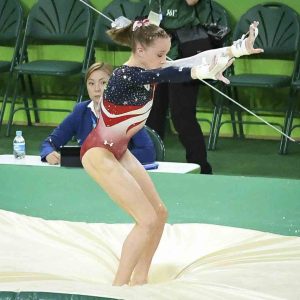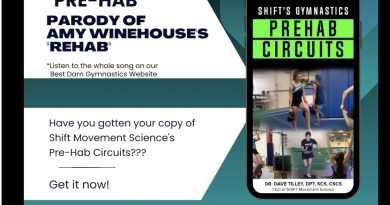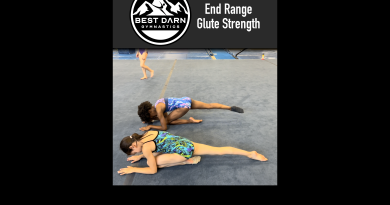 One of the biggest differences between gymnastics and every other sport is the ground impact forces gymnasts have to endure regularly at high volume levels. All this means is that gymnasts have to absorb unbelievable amounts of force when they perform their skills, and they do these skills and landings A LOT. Here are a few stats to consider.
One of the biggest differences between gymnastics and every other sport is the ground impact forces gymnasts have to endure regularly at high volume levels. All this means is that gymnasts have to absorb unbelievable amounts of force when they perform their skills, and they do these skills and landings A LOT. Here are a few stats to consider.
Gymnasts must absorb the following ground reaction forces during 2 footed landings:
- Approximately 5x bodyweight in practice (average forces between practice landing surfaces)
- Approximately 11x bodyweight in competition
- Approximately 18x bodyweight if the landing is uneven (on the specific side being loaded more)
Furthermore, some stats on landing a dismount from uneven bars/rings/horizontal bar:
- T12/L1 compression forces (intervertebral disc pressure) average over 11.6x bodyweight within the first 50 milliseconds of landing.
- The forces of these dismounts can peak around 20x bodyweight
 These forces are a massive part of gymnast injuries and therefore must also play a massive role in the rehab process. If the ability to absorb high levels of force is totally absent from a rehab process, the athlete is most likely being set up for re-injury or chronic pain. As such, the following principles are non-negotiable must haves for any gymnastics’ rehab program but especially for injuries related to compression/ground reaction forces.
These forces are a massive part of gymnast injuries and therefore must also play a massive role in the rehab process. If the ability to absorb high levels of force is totally absent from a rehab process, the athlete is most likely being set up for re-injury or chronic pain. As such, the following principles are non-negotiable must haves for any gymnastics’ rehab program but especially for injuries related to compression/ground reaction forces.
- Single and double leg landings from various height and various angles
- Various types of jumps. The amount of forces that must be absorbed vary between drills, individual skills and connected skills. As such, single and double leg standard jumps, rebound jumps, and depth jumps must all be performed at different points in the rehab process. I even incorporate shallow weighted landings at end stage.
- Resistance training aka lifting weights must be included. This is still relatively new to the sport as weight training used to get a (falsely) bad reputation for leading to excessive bulkiness and tightness. However, a well-executed weight training program is arguably the best way to imitate and improve the bodies capacity to absorb and control high forces while an athlete is injured and missing practices/meets. This is especially true for back injuries related to compression forces.
- If the athlete is able to continue practicing through the process, landing/jumping/sprinting volumes MUST be monitored closely. Unfortunately, regardless of how perfectly planned a rehab program is constructed, the medical professional must be aware of daily/weekly landing and jumping volumes as they often need to be reduced initially. Landing surfaces also often need to be changed initially during the rehabilitation process. Takeaway here is that the practitioner must be aware of how their athlete is practicing throughout the process.
**It is important to note that some of these cannot be immediately introduced post-injury and are most likely introduced after the initial acute, hyper sensitive, inflammatory phase has passed.
Finally, and most importantly, numbers 1, 2, and 3 MUST be involved regardless of the nature of injury. For example, if an athlete has an injury like a wrist fracture and will miss practice for an extended period of time, the ability for the rest of their body to handle gymnastics forces will decline significantly if it is not continually trained. Practitioners are so used to focusing in on just the injured area, but the rest of the athlete’s body must remain prepared (or preferable be stronger) so that when the athlete can return to sport, the rest of their body is ready to handle all the stresses. Failure to do this leads to a massively increased risk of injuring a different body part within a short time of returning to sport. This is probably the biggest issue I see in gymnastics care and worth its’ own article one day, but for now the concept is that regardless of injury, a rehab program for gymnasts must always include full body strength and conditioning in addition to treating the injured area directly.
Dr. William Cavanaugh DPT, CSCS
Resilient Athlete LLC
Instagram @resilient_athlete_pt
- Sources: Bruggermann DP Harringe ML. Biomechanics: injury mechanisms and risk factors. In Caine DJ., Russell K., Lim L. The Handbook of Sports Medicine: Gymnastics. 2013. Wiley-Blackwell: Oxford, pp 63 – 84




